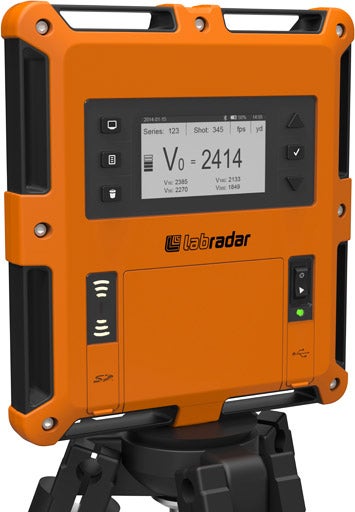No More Chronograph? Labradar is Personal Doppler Radar That Does Much More
Russ Chastain 02.02.15

While strolling the SHOT Show, I answered the siren song that so many of us cannot refuse: Free beer. While standing in line for that, I noticed a display that caught my attention and made a mental note to return to it a while later. The booth was for Labradar, and it proclaimed that the chronograph era is over. A bold and intriguing statement.
A fancy-looking rectangular unit was attached to a tripod, and I had to stop and ask about it.

I spoke with the wife of the husband-wife team, who said they’d hit a snag after debuting Labradar at the 2014 SHOT Show. Their manufacturer had experienced some serious health issues and essentially left them without product to sell. Bummer, especially when you start thinking about this stuff like a serious shooter, and you’ve been let down by chronographs in the past.
Labradar uses Doppler radar instead of two light sensors and offers much more than a chrony. It continues to track and record info on your bullet or arrow even downrange, and can tell you its velocity at multiple ranges in any light condition.
At multiple ranges! In any light condition! Oh man.
The Labradar does more than I can report here, but I’ll do my best.
Setup may be the easiest part. Just place it so that the projectile will pass to one side of the Labradar unit. It doesn’t have to be right next to the unit; you want to be a little ways off to one side. I was told that your muzzle and the Labradar should be equidistant from the target.
There is a notch on top of the Labradar that you align with the intended path of the bullet or arrow (aim it at the target you will be shooting).

Did you notice that you don’t have to shoot through a little window and that the unit is not in the line of fire?
After each shot, Labradar provides muzzle velocity and five actual downrange velocities. Also available: Maximum Velocity, Minimum Velocity, Average Velocity, Standard Deviation, and Extreme Spread.
Accuracy is reportedly 0.1%. Data is downloadable, and an SD card slot is built-in.
Labradar says it’s accurate with subsonic, trans-sonic, and supersonic projectiles, and it can record a “virtually unlimited number” of shots and shot series.
Uses 6 AA batteries, and you can power it with an external USB battery pack if you need to.
Different bullets can be read at different ranges. Preliminary testing has shown these approximate range limitations for some popular cartridges. I was told that these are conservative, and the Labradar may read them further out:
- 22 LR: 50-60 yards
- 223 Rem: 40-60 yards
- 270 Win: 50-70 yards
- 308 Win with boattail bullet: 60-80 yards
- 308 Win with flat base bullet: 100 yards
- 9mm Luger: 100+ yards
- 40 S&W: 130 yards
- 45 ACP: 140 yards
- Continuous arrow tracking reaches out to 70 yards or more.
Customizable setup provides the following menu choices:
- Velocity units: Choose feet per second (fps), yards per second (yps), miles per hour (mph), meters per second (m/s), or kilometers per hour (kph).
- Distance units: Select feet, yards, or meters for the distance from the unit to your projectile for downrange data.
- Weight units: Select grams or grains for the weight of your projectile.
- Select velocity range: Choose from Rifle (1000-3900 fps), Handgun (250-1700 fps), or Archery (65-700 fps) settings. An on-screen icon reminds you what mode you’ve selected after you exit the menu.
- Set projectile offset: The distance (in inches) from the gun’s muzzle (or arrow tip) to the side of the Labradar unit.
- Set distances: Choose five downrange distances at which the Labradar will report your projectile’s velocity.
- Projectile weight: Enter the weight of your bullet or arrow to the nearest 0.1 grain or 0.1 gram. (Weights are used for calculating energy and power factor.)
- Arm time: Your “time window” during which you can shoot and have the info recorded. The shorter the arm time, the faster your response must be; the longer the arm time, the faster the batteries will be used up.
- Screensaver: Allows screen to turn off to save battery power (unit still operates with screen off). Push any button to turn the screen back on.
- Trigger Source: Choose between Trigger and Doppler. (Use Doppler only for large, slow objects. Always use Trigger for firearms.)
- Trigger Level: Sensitivity of the triggering; levels 1-5 with 1 being most sensitive. Lower sensitivity can prevent neighboring shooters from triggering your radar.
- Transmit (TX) channel: Select radar frequency, which is useful for using multiple radars near one another.
- Transmit (TX) power: Choose between Standard or Low. Standard reaches farther out; low works better for short range or in a crowded area with a lot of radar signal reflection. And it’s apparently illegal to use high power in some countries(!).
- System date: self explanatory.
- System time: set the clock.
- Format SD card: self explanatory.
- Format Internal memory: self explanatory.
- About: Provides serial number and firmware version.
What I know for certain right now is that I want a Labradar. A lot.
Update: I just got word that Labradar’s MSRP will be $559.95, and it will be available for sale online at http://www.mylabradar.com/ and at local dealers when supplies become available.
Currently, Labradar is expected to be in stock by early April, 2015.